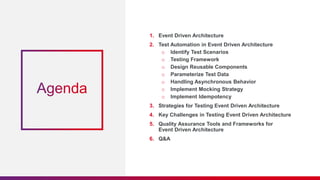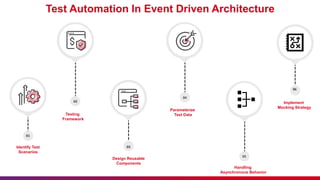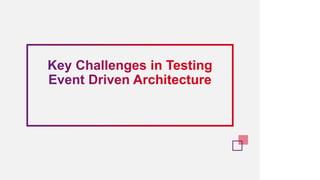The document discusses testing strategies and challenges related to event-driven architecture, including the importance of etiquette during testing sessions. It outlines key components of event-driven systems such as event producers, brokers, and consumers, and provides guidelines for test automation, including identifying scenarios and managing asynchronous behavior. It also addresses various tools and frameworks conducive to testing event-driven systems, emphasizing the need for thoroughness in scenarios involving fault tolerance, security, and distributed interactions.










![Parameterize Test Data
• Use parameterization to vary test data and cover a wide range of scenarios.
• Ensure that test data is easily maintainable and can be updated without modifying the entire test script.
• For Example:
@DataProvider(name = "orderData")
public Object[][] orderData() {
return new Object[][] {
{ "orderId1", Arrays.asList(item1, item2) },
{ "orderId2", Arrays.asList(item3, item4) },
// Additional test data
};
}
@Test(dataProvider = "orderData")
public void testOrderProcessingEvent(String orderId, List<Item> items) {
OrderEvent orderEvent = EventUtils.createOrderEvent(orderId, items);
}](https://image.slidesharecdn.com/testingeventdrivenarchitecture-240312094941-41cfec22/85/Testing-Event-Driven-Architecture-Presentation-11-320.jpg)
















